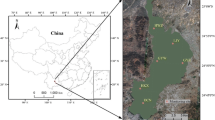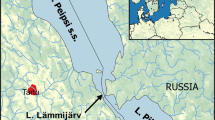Abstract
Lake ecosystems follow convoluted trajectories impacted by climate change and human stress. In this study, we developed the filtering trajectory method (FTM), a mathematical model, to establish the empirical relationships between chlorophyll a (CHLa) and nutrient concentrations in eutrophic Dianchi Lake, China. FTM can identify cause-effect relationships over time in apparently stochastic data, and a filtering trajectory diagram is used to describe the driving forces of the complex trajectories of individual lake ecosystems. Our analysis showed that the nutrient concentrations of overlying water in Dianchi Lake have decreased to the levels recorded in the late 1980s and early 1990s, but CHLa has not declined synchronously. The ecosystem trajectories revealed the ups and downs of complex processes, which can be divided into four stages: (1) pollution stage (1988–1999): a macrophyte-to-phytoplankton transition occurred with an increase in nutrient inputs and a rise in temperature; (2) initial restoration stage (2000–2006): the response of CHLa to the nutrient load reduction presented an apparent time lag, or hysteresis effect; (3) recurrence stage (2007–2011): excessive water consumption and continuous drought in the watershed resulted in an increasing trend in CHLa, TP and TN; and (4) re-restoration stage (2012–2016): the implementation of a water-replenishment project resulted in a declining trend. Our approach can greatly improve our understanding of how lakes respond to broad changes in environmental conditions (e.g. climate warming) and improve water quality via targeted nutrient management, from “static” to “dynamic management” and from “One Standard for One Lake” to “Multiple Standards for One Lake”.



Similar content being viewed by others
References
Aizaki, M. (1981). Application of modified Carlsons trophic state index to Japanese lakes and its relationships to other parameters related to trophic state. Res Rep Natl Inst Environ Stud Jpn, (23), 13–31.
Brock, W. A., Dechert, W. D., LeBaron, B., & Schenkman, J. A. (1996). A test for independence based on the correlation dimension. Econometric Reviews, 15(3), 197–235.
Canfield, D. E. (1983). Prediction of chlorophyll a concentrations in Florida lakes: the importance of phosphorus and nitrogen. Water Resources Bulletin, 19(2), 255–262.
Carlson, R. E. (1977). A trophic state index for lakes. Limnology and Oceanography, 22, 361–368.
Carpenter, S. R., & Pace, M. L. (1997). Dystrophy and eutrophy in lake ecosystems implications of fluctuating inputs. Oikos, 78(1), 3–14.
Carstensen, J., Sánchezcamacho, M., Duarte, C. M., Krausejensen, D., & Marbà, N. (2011). Connecting the dots: responses of coastal ecosystems to changing nutrient concentrations. Environmental Science and Technology, 45(21), 9122–9132.
Chorus, I., Dokulil, M. T., Lammens, E. H. H. R, Manca, M., Naselli-Flores, L., Nixdorf, B., Persso, G., Schindler, D., Straile, D., Tátrai, I., Tadonléké, R. & Willén, E. (2011). Restoration responses of 19 lakes: are TP thresholds common?. In I. Chorus, & I. Schauser (a cura di), Oligotrophication of Lake Tegel and Schlachtensee, Berlin. Analysis of system components, causalities and response thresholds compared to responses of other waterbodies (pp. 84–102). Dessau-Roßlau : Federal Environment Agency.
Cleveland, W. S. (1979). Robust locally weighted regression and smoothing scatterplots. Journal of the American Statistical Association, 74(368), 829–836.
Conley, D. J., Paerl, H. W., Howarth, R. W., Boesch, D. F., Seitzinger, S. P., Havens, K. E., Lancelot, C., & Likens, G. E. (2009). Controlling eutrophication: nitrogen and phosphorus. Science, 323(5917), 1014–1015.
Cooke, G. D. (1999). Ecosystem rehabilitation. Lake and Reservoir Management, 15, 1–4.
Cooke, G. D., Welch, E. B., Peterson, S. A., & Nichols, S. A. (2005). Restoration and management of lakes and reservoirs (3rd ed.). Boca Raton, FL: CRC/Tayolr & Francis 591 pp. ISBN 1-56670-625-4.
Dillon, P. J., & Rigler, F. H. (1974). The phosphorus-chlorophyll relationship in lakes. Limnology and Oceanography, 19(5), 767–773.
Duarte, C. M., Conley, D. J., Carstensen, J., & Sánchez-Camacho, M. (2009). Return to Neverland: Shifting baselines affect eutrophication restoration targets. Estuaries and Coasts, 32(1), 29–36.
Florida Lakewatch. (2000). A Beginner’s guide to water management-nutrients. Information Circular No. 102. Gainesville, Florida, USA: Department of Fisheries and Aquatic Sciences and Institute of Food and Agricultural Sciences, University of Florida.
Huber, W., Brezonik, P., Heaney, J., Dickinson, R., Preston, S., Swornik, S., & Demaio, M. (1982). A classification of Florida lakes. Gainesville, Fla: Water Resources Research Center, University of Florida.
Huo, S., Ma, C. Z., Xi, B. D., Gao, R. T., Deng, X. Z., Jiang, T. T., He, Z. S., Su, J., Wu, F., & Liu, H. L. (2014). Lake ecoregions and nutrient criteria development in China. Ecological Indicators, 46(46), 1–10.
Jeppesen, E., Søndergaard, M., Jensen, J. P., Havens, K. E., Anneville, O., Carvalho, L., Coveney, M. F., Deneke, R., Dokulil, M., Foy, B., Gerdeaux, D., Hampton, S. E., Hilt, S., Kangur, K., Köhler, J., Lammens, E. H. H. R., Lauridsen, T. L., Manca, M., Miracle, M. R., Moss, B., Noges, P., Persson, G., Phillips, G., Portielje, R., Romo, S., Schelske, C. L., Straile, D., Tatrai, I., Willen, E., & Winder, M. (2005). Lake responses to reduced nutrient loading—an analysis of contemporary long-term data from 35 case studies. Freshwater Biology, 50, 1747–1771.
Jeppesen, E., Søndergaard, M., Meerhoff, M., Lauridsen, T. L., & Jensen, J. P. (2007). Shallow lake restoration by nutrient loading reduction: some recent findings and challenges ahead. Hydrobiologia, 584(1), 239–252.
Lewis, W. M., Wurtsbaugh, W. A., & Paerl, H. W. (2011). Rationale for control of anthropogenic nitrogen and phosphorus to reduce eutrophication of inland waters. Environmental Science & Technology, 45(24), 10300–10305.
Meijer, M. L. (2000). Biomanipulation in the Netherlands—15 years of experience. PhD Thesis, Wageningen Agricultural University, Wageningen, The Netherlands, 15–24.
Moog, O., Kloiber, A. S., Thomas, O., & Gerritsen, J. (2004). Does the ecoregion approach support the typological demands of the EU ‘water framework directive’? Hydrobiologia, 516(1–3), 21–23.
Omernik, J. M. (1987). Ecoregions of the conterminous United States. Annals of the Association of American Geographers, 77, 118–125.
Padovesi-Fonseca, C., Philomeno, M. G., & Andreoni-Batista, C. (2009). Limnological features after a flushing event in Paranoá Reservoir, central Brazil. Acta Limnologica Brasiliensia, 21(3), 277–285.
Prairie, Y. T., Duarte, C. M., & Kalff, J. (1989). Unifying nutrient chlorophyll relationships in lakes. Canadian Journal of Fisheries and Aquatic Sciences, 46(7), 1176–1182.
Pridmore, R. D., & Mcbride, G. B. (1984). Prediction of chlorophyll a concentrations in impoundments of short hydraulic retention time. Journal of Environmental Management, 19(4), 343–350.
Quirós, R. (1990). Factors related to variance of residuals in chlorophyll — total phosphorus regressions in lakes and reservoirs of Argentina. Hydrobiologia, 200-201(1), 343–355.
Sakamoto, M. (1966). The chlorophyll amount in the euphotic zone in some Japanese lakes and its significance in the photosynthetic production of phytoplankton community. Shokubutsugaku Zasshi, 79(932–933), 77–88.
Scheffer, M. (1990). Multiplicity of stable states in freshwater systems. Hydrobiologia, 200-201(1), 475–486.
Scheffer, M., Carpenter, S., Foley, J. A., Folke, C., & Walker, B. (2001). Catastrophic shifts in ecosystems. Nature, 413(6856), 591–596.
Schelske, C. L. (2009). Eutrophication: focus on phosphorus. Science, 324(5928), 724–725.
Schindler, D. W. (1977). Evolution of phosphorus limitation in lakes. Science, 195(4275), 260–262.
Smith, V. H. (1982). The nitrogen and phosphorus dependence of algal biomass in lakes: an empirical and theoretical analysis. Limnology and Oceanography, 27(6), 1101–1112.
Smith, V. H. (1983). Low nitrogen to phosphorus ratios favors dominance by blue green algae in lake phytoplankton. Science, 221(4611), 669–671.
Tadonleke, R. D., Lazzarotto, J., Anneville, O., & Druart, J. C. (2009). Phytoplankton productivity increased in Lake Geneva despite phosphorus loading reduction. Journal of Plankton Research, 31(10), 1179–1194.
Vollenweider, R. A. (1968). Scientific fundamentals of the eutrophication of lakes and flowing waters with particular reference to nitrogen and phosphorus as factors in eutrophication, Organization for Economic Cooperation and Development technical report DAS/CSI/68 (Vol. 27, p. 250). Paris: OECD.
Xu, H., Paerl, H. W., Zhu, G. W., Qin, B. Q., Hall, N. S., & Zhu, M. Y. (2016). Long-term nutrient trends and harmful cyanobacterial bloom potential in hypertrophic Lake Taihu, China. Hydrobiologia, 787(1), 1–14.
Acknowledgements
This research was supported by the National Water Special Project (2012ZX07506-008, 2017ZX07301-003). We greatly appreciate the constructive review provided by Dr. Yutao. We thank the Kunming Research Academy of Environmental Sciences for providing the water quality data.
Author information
Authors and Affiliations
Corresponding author
Additional information
Publisher’s note
Springer Nature remains neutral with regard to jurisdictional claims in published maps and institutional affiliations.
Rights and permissions
About this article
Cite this article
Zhao, J., Fu, G. Assessment of lake eutrophication recovery: the filtering trajectory method (FTM) and its application to Dianchi Lake, China. Environ Monit Assess 191, 360 (2019). https://doi.org/10.1007/s10661-019-7492-2
Received:
Accepted:
Published:
DOI: https://doi.org/10.1007/s10661-019-7492-2




